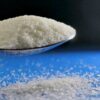Hydrochloric Acid
Hydrochloric acid (HCl) is a colorless, highly pungent solution of hydrogen chloride in water. It’s a strong, corrosive acid commonly used in various industries and laboratory settings. Here is an overview of hydrochloric acid, covering its chemical properties, production, uses, safety precautions, and environmental impact in simple terms.
Chemical Properties
- Formula: HCl
- Molar Mass: 36.46 g/mol
- Physical State: Colorless liquid
- Odor: Pungent, irritating odor
- Solubility: Highly soluble in water
- pH: Typically ranges from 0 to 1 for concentrated solutions, indicating high acidity
Production
- Industrial Production: Produced primarily by the reaction of chlorine gas with hydrogen gas. This is done using the following reaction: Cl2+H2→2HCl\text{Cl}_2 + \text{H}_2 \rightarrow 2\text{HCl}
- Laboratory Production: Can be produced by combining a strong acid (like sulfuric acid) with a chloride salt (like sodium chloride). NaCl+H2SO4→NaHSO4+HCl\text{NaCl} + \text{H}_2\text{SO}_4 \rightarrow \text{NaHSO}_4 + \text{HCl}
Uses
- Industrial Use:
- Chemical Manufacturing: Used to produce a variety of chemicals, including vinyl chloride (for PVC), fertilizers, and dyes.
- Metal Processing: Employed in pickling of steel, removing rust and scale from metals before processing.
- Petroleum Industry: Helps in refining crude oil and in the production of organic compounds.
- Food Industry: Used as an additive (E507) to regulate acidity and for the production of gelatin.
- Laboratory Use:
- Reagent: Commonly used for pH control, titrations, and preparation of inorganic and organic compounds.
- Cleaning Agent: Effective in cleaning laboratory glassware and equipment.
- Domestic Use:
- Cleaning Products: Found in household cleaners for removing stains, scale, and rust.
- Descaling: Used to clean and descale kettles, toilets, and other household items.
Safety Precautions
- Handling:
- Always wear appropriate personal protective equipment (PPE), including gloves, goggles, and protective clothing.
- Use in well-ventilated areas to avoid inhaling fumes.
- Storage:
- Store in a cool, dry place away from incompatible materials like bases and oxidizing agents.
- Keep containers tightly closed and properly labeled.
- First Aid:
- Skin Contact: Rinse immediately with plenty of water. Remove contaminated clothing.
- Eye Contact: Rinse cautiously with water for several minutes. Seek medical attention if irritation persists.
- Inhalation: Move to fresh air and seek medical advice if symptoms occur.
- Ingestion: Do not induce vomiting. Rinse mouth with water and seek immediate medical assistance.
Environmental Impact
- Aquatic Life: Highly toxic to aquatic organisms. Can cause severe damage to aquatic ecosystems if released in large quantities.
- Soil Contamination: Can lower soil pH, affecting plant growth and soil organisms.
- Air Pollution: When released into the air, it forms hydrochloric acid mist, contributing to respiratory problems in humans and animals.
Storage and Transportation
- Containers: Use corrosion-resistant containers made from materials like glass, plastic, or rubber-lined steel.
- Labeling: Properly label containers with hazard symbols and safety information.
- Transportation: Transport in compliance with local regulations. Ensure that containers are secure and protected from physical damage.
Disposal
- Neutralization: Neutralize small quantities with a base (like sodium bicarbonate) before disposal.
- Regulations: Follow local, state, and federal regulations for disposal. Do not pour hydrochloric acid down the drain without proper neutralization and authorization.
First Aid Measures
- In Case of Skin Contact: Immediately wash with plenty of water. Remove contaminated clothing.
- In Case of Eye Contact: Rinse cautiously with water for several minutes. Remove contact lenses if present and easy to do.
- If Inhaled: Move the person to fresh air and keep them comfortable. Seek medical attention if symptoms occur.
- If Ingested: Do not induce vomiting. Rinse mouth with water. Seek immediate medical attention.
Regulatory Information
- Occupational Exposure Limits: Regulations specify permissible exposure limits to protect workers from harmful effects.
- Labeling Requirements: Containers must be labeled with appropriate hazard symbols and safety information.
Interesting Facts
- Stomach Acid: Hydrochloric acid is naturally present in the stomach, where it aids in digestion and protects against pathogens.
- Historical Use: Used by alchemists in the Middle Ages and was historically known as “muriatic acid.”
- Volcanoes: Hydrochloric acid is released during volcanic eruptions, contributing to environmental acidification.
Hydrochloric acid is a versatile and essential chemical with a wide range of applications. However, its strong corrosive nature requires careful handling, storage, and disposal to ensure safety and environmental protection.




